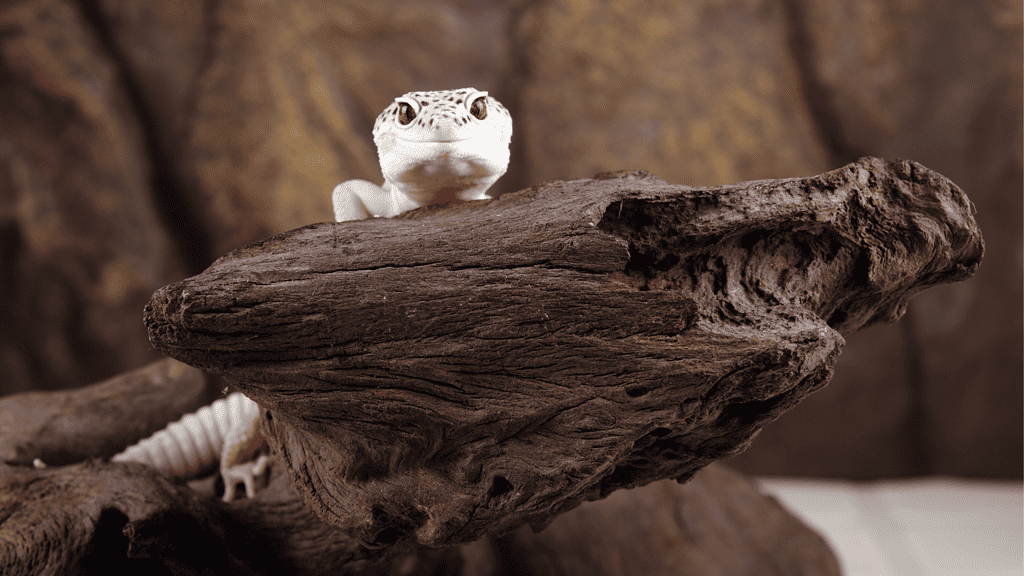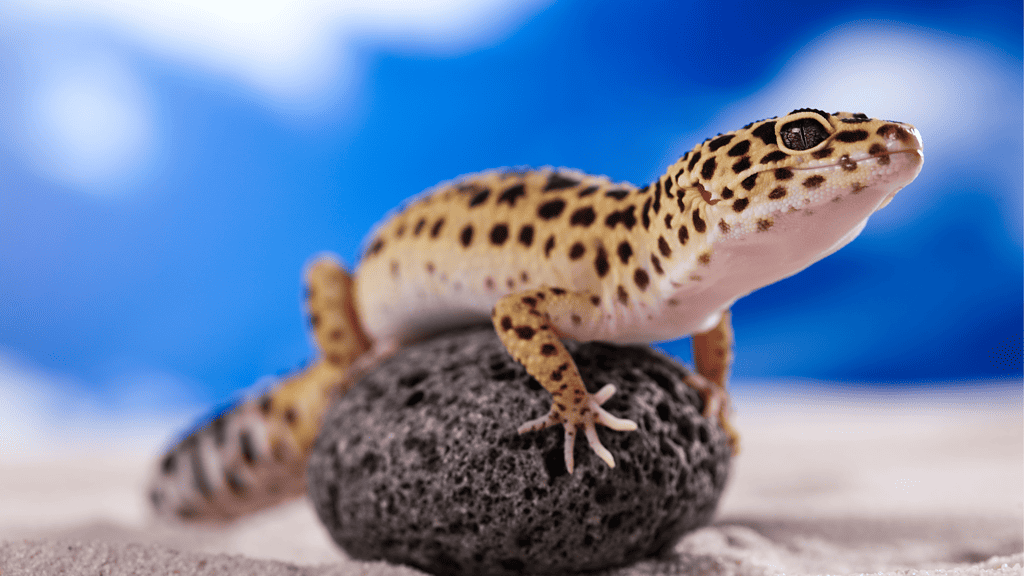The Leopard Gecko or Leo is a stunning one-of-a-kind lizard that is well-known for its striking look that resembles that of a leopard and its enormous tail that serves as a fat-storage area. We all know they are beautiful but are they easy to care for, or are they low maintenance?

The maintenance required for leopard geckos is relatively minimal. Generally, they do not require much attention and are easy to care for. They also do not require much cage care, but you should still pay a lot of attention to their habitat. Leos are nocturnal creatures that are often gentle and simple to domesticate.
Behavior & Temperament
Most leopard geckos will spend the day stashed away in their own hide boxes. You could get a glimpse of them enjoying the sun on occasion, but most of their activities take place in the early morning and late evening hours.
Although these reptiles move somewhat slowly, this certainly does not mean they are uninteresting!
They are really pretty adept at interacting with people and can convey their thoughts and needs through squeaks. When they are hungry, you could hear them chirping at each other.
It is not impossible to maintain many leopard geckos together in the same enclosure. However, in order to prevent conflict, you will need to design the layout appropriately. It is not a good idea to keep males together under any circumstances since they might get territorial & fight.
Before engaging in combat, males will frequently display their tales to intimidate their opponents. You could also witness them moving their tails back and forth as a snake might. If you notice any of this, you have no choice but to separate your Leos as quickly as you can.
Possible Health Risks
Even though they are hardy, leopard geckos are susceptible to several different health problems.
The accumulation of unhealthful fat is a particular concern. These lizards can have health issues on the inside if they gain too much weight.
They may begin to store fat & nutrients in pockets around the arms, which may be seen outside the body. If this happens, try reducing the amount of food your lizard eats. As they lose weight, the bubbles should disappear.
These reptiles are at an increased risk for MBD when they do not receive adequate exposure to UVB rays. The reptile body would not be able to metabolize calcium for the skeletons if it was not exposed to UVB rays. As a direct consequence of this, their skeletons become fragile and easily fractured.
There is a possibility that younger geckos can experience spinal difficulties or growth defects. Ensure that your gecko has access to optimal UVB light during these critical years of its life.
There is also a possibility that leopard geckos will become ill as a result of problems with their cage. These geckos are susceptible to developing dysecdysis when the moisture levels are too low. This condition is characterized by dry skin and visual issues.
Infections of the respiratory tract can result from excessive humidity. This results in inflammation, increased mucus production, and difficulty breathing. Utilize your hygrometer to guarantee that you maintain optimal humidity levels to circumvent the aforementioned issues.
Handling Tips
Leopard geckos are relatively docile and gentle. They have never been reported to bite people (their teeth don’t seem to cause too much pain anyhow).
They usually don’t mind being handled, but it’s essential to be able to read your Leo’s mind and determine how they’re feeling at all times.
Overhandling these geckos can cause them to get anxious; thus, it is essential to monitor them constantly for feedback. If they begin to struggle against your hands and attempt to flee their cage, place them back within it.
It is essential to allow Leo some time to respond. The longer you provide care for them, the more comfortable they will become. If you respect their limits and don’t cross them, you shouldn’t have any problems interacting with them.
Leos only need these three essential maintenance factors, and their housing/caring needs are satisfied
· Make sure that Leo’s habitat is cozy and comfy
Geckos are desert animals that spend their lives in the wild, so it only seems sensible that they thrive in warm, dry environments. But you wouldn’t believe it if we told you that this environment isn’t always the most appropriate for them. Even while the bodies of leopard gecko are able to adjust to varying amounts of food and water, recreating the conditions of their natural habitat in confinement is the best way to ensure that your gecko lives out its full potential. If they are given the proper level of attention, management, and care while kept in captivity, leopard geckos are more likely to live longer. A terrarium that has adequate ventilation and a cover that is screened in is the kind of enclosure that is ideal for this kind of animal. Multiple geckos can share a single terrarium if only a single species male is present. But what is the optimal size? A tank with dimensions of 30 by 12 by 12 inches (or 76 by 31 by 31 centimeters) is suitable for housing one lizard. If you are considering buying more than one Leos, you should consider increasing the size of your aquarium to provide a habitat that is more suited to their numbers.
· Give its health the highest priority
Even though caring for a leopard gecko is usually not too difficult, there are a few things that you should put at the top of your list of priorities. To begin, the food your lizard consumes is essential for its continued existence. The first thing you should do to improve its health is to ensure it gets the nourishment it needs. It is necessary to include calcium powder in your gecko’s food because the majority of feeding insects do not include the minerals required for your Leopard gecko.
They are known as insectivores, which indicates that insects make up their ideal diet. You should provide your Leos with a diet consisting primarily of insects such as:
- Crickets
- Smaller Mealworms
- Waxworms
- Dubia Roaches
- Silkworms
- Superworms
Make sure that the insects you give your gecko are the suitable size for them. Geckos who are just starting out need to eat smaller insects, whereas geckos that are fully grown prefer the larger ones.
Second, when you introduce your pet into its new environment, you should allow it some room for at least 3 to 4 days so that it may become accustomed to its surroundings. Your gecko may become ill as a result of the stress caused by adapting to a totally different environment that features strange surroundings.
In addition to this, it is recommended that you take your gecko to the veterinarian for a checkup not long after you obtain it and then every year after that.

· Watch out for the warning signs!
It may be time to take your lizard to the veterinarian if it begins behaving unusually or exhibiting any symptoms that cause you concern. If you take your leopard gecko to the veterinarian regularly, they may be able to enjoy a longer and happier life. If you see any of the following symptoms, it is highly recommended that you take your pet to the veterinarian for an examination:
- Keeping a lower profile than usual
- Off-feed
- Dropping some pounds
- Swollen joints
- Problems with the eyes, ears, or mouth
- Problems with visible shedding as well as discoloration of the skin
- Excessive diarrhea or bowel movements are not usual for more than two days.
- Uneasy and labored breaths
- Skin conditions such as bumps, sores, and abrasions
If you take good care of your lizard, there is a chance that it will live longer, but even if that doesn’t happen, you can be certain that it will have led a happy life since it was in your care.
